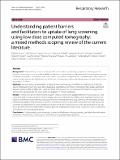Files in this item
Understanding patient barriers and facilitators to uptake of lung screening using low dose computed tomography : a mixed methods scoping review of the current literature
Item metadata
| dc.contributor.author | Cavers, Debbie | |
| dc.contributor.author | Nelson, Mia | |
| dc.contributor.author | Rostron, Jasmin | |
| dc.contributor.author | Robb, Kathryn A | |
| dc.contributor.author | Brown, Lynsey R | |
| dc.contributor.author | Campbell, Christine | |
| dc.contributor.author | Akram, Ahsan R | |
| dc.contributor.author | Dickie, Graeme | |
| dc.contributor.author | Mackean, Melanie | |
| dc.contributor.author | van Beek, Edwin J R | |
| dc.contributor.author | Sullivan, Frank | |
| dc.contributor.author | Steele, Robert J | |
| dc.contributor.author | Neilson, Aileen R | |
| dc.contributor.author | Weller, David | |
| dc.date.accessioned | 2023-01-06T17:30:02Z | |
| dc.date.available | 2023-01-06T17:30:02Z | |
| dc.date.issued | 2022-12-23 | |
| dc.identifier | 282799299 | |
| dc.identifier | ca345425-9cf9-4cf7-b4a4-b47513763bcf | |
| dc.identifier | 36564817 | |
| dc.identifier | 85144636735 | |
| dc.identifier | 000922378300001 | |
| dc.identifier.citation | Cavers , D , Nelson , M , Rostron , J , Robb , K A , Brown , L R , Campbell , C , Akram , A R , Dickie , G , Mackean , M , van Beek , E J R , Sullivan , F , Steele , R J , Neilson , A R & Weller , D 2022 , ' Understanding patient barriers and facilitators to uptake of lung screening using low dose computed tomography : a mixed methods scoping review of the current literature ' , Respiratory research , vol. 23 , 374 . https://doi.org/10.1186/s12931-022-02255-8 | en |
| dc.identifier.issn | 1465-9921 | |
| dc.identifier.other | PubMedCentral: PMC9789658 | |
| dc.identifier.uri | https://hdl.handle.net/10023/26706 | |
| dc.description | Funding: The LUNGSCOT study is funded by the Chief Scientists Office of the Scottish Government, reference HIPS/19/52. | en |
| dc.description.abstract | BACKGROUND: Targeted lung cancer screening is effective in reducing mortality by upwards of twenty percent. However, screening is not universally available and uptake is variable and socially patterned. Understanding screening behaviour is integral to designing a service that serves its population and promotes equitable uptake. We sought to review the literature to identify barriers and facilitators to screening to inform the development of a pilot lung screening study in Scotland. METHODS: We used Arksey and O'Malley's scoping review methodology and PRISMA-ScR framework to identify relevant literature to meet the study aims. Qualitative, quantitative and mixed methods primary studies published between January 2000 and May 2021 were identified and reviewed by two reviewers for inclusion, using a list of search terms developed by the study team and adapted for chosen databases. RESULTS: Twenty-one articles met the final inclusion criteria. Articles were published between 2003 and 2021 and came from high income countries. Following data extraction and synthesis, findings were organised into four categories: Awareness of lung screening, Enthusiasm for lung screening, Barriers to lung screening, and Facilitators or ways of promoting uptake of lung screening. Awareness of lung screening was low while enthusiasm was high. Barriers to screening included fear of a cancer diagnosis, low perceived risk of lung cancer as well as practical barriers of cost, travel and time off work. Being health conscious, provider endorsement and seeking reassurance were all identified as facilitators of screening participation. CONCLUSIONS: Understanding patient reported barriers and facilitators to lung screening can help inform the implementation of future lung screening pilots and national lung screening programmes. | |
| dc.format.extent | 18 | |
| dc.format.extent | 1418277 | |
| dc.language.iso | eng | |
| dc.relation.ispartof | Respiratory research | en |
| dc.subject | Humans | en |
| dc.subject | Early Detection of Cancer | en |
| dc.subject | Lung Neoplasms/diagnostic imaging | en |
| dc.subject | Lung | en |
| dc.subject | Tomography | en |
| dc.subject | Scotland | en |
| dc.subject | RC0254 Neoplasms. Tumors. Oncology (including Cancer) | en |
| dc.subject | SDG 3 - Good Health and Well-being | en |
| dc.subject | MCC | en |
| dc.subject.lcc | RC0254 | en |
| dc.title | Understanding patient barriers and facilitators to uptake of lung screening using low dose computed tomography : a mixed methods scoping review of the current literature | en |
| dc.type | Journal item | en |
| dc.contributor.sponsor | Chief Scientist Office | en |
| dc.contributor.institution | University of St Andrews. School of Medicine | en |
| dc.contributor.institution | University of St Andrews. Population and Behavioural Science Division | en |
| dc.contributor.institution | University of St Andrews. Sir James Mackenzie Institute for Early Diagnosis | en |
| dc.identifier.doi | https://doi.org/10.1186/s12931-022-02255-8 | |
| dc.description.status | Peer reviewed | en |
| dc.identifier.grantnumber | HIPS/19/52 | en |
This item appears in the following Collection(s)
Items in the St Andrews Research Repository are protected by copyright, with all rights reserved, unless otherwise indicated.

